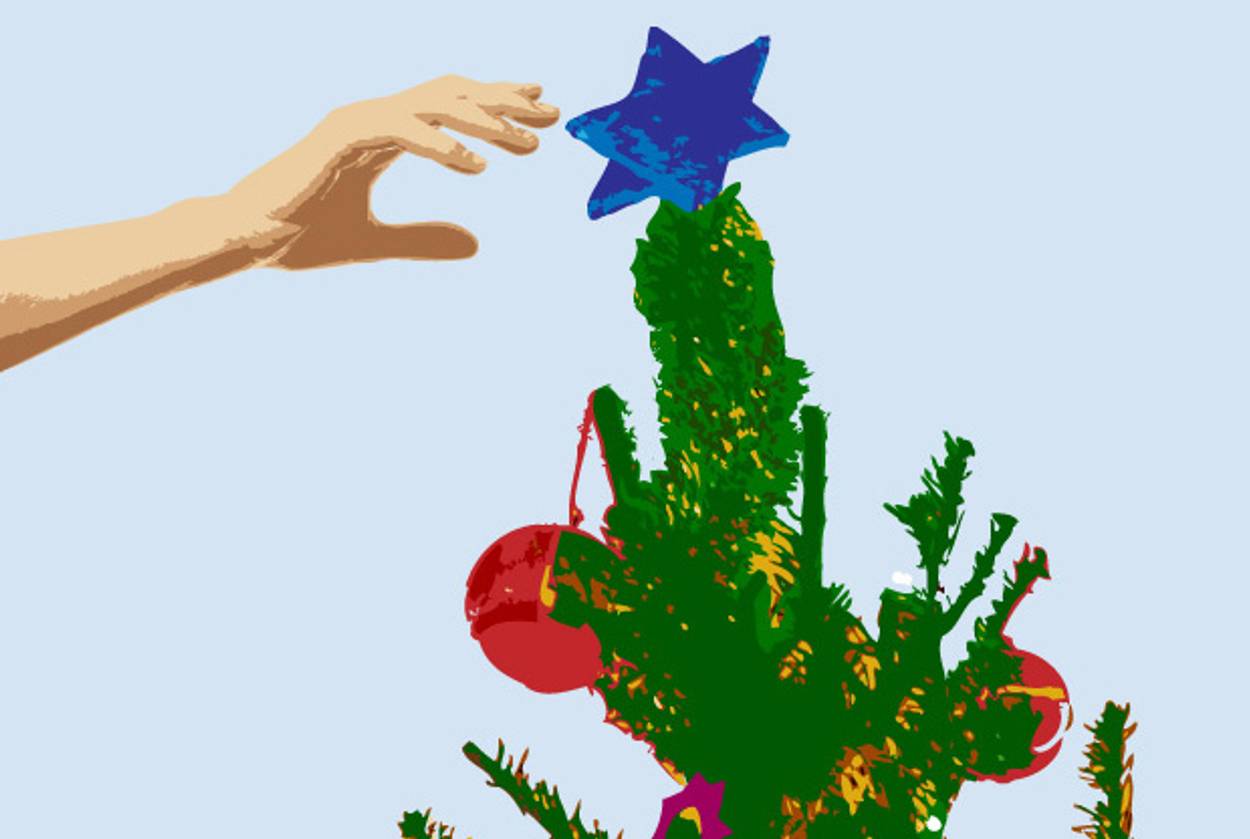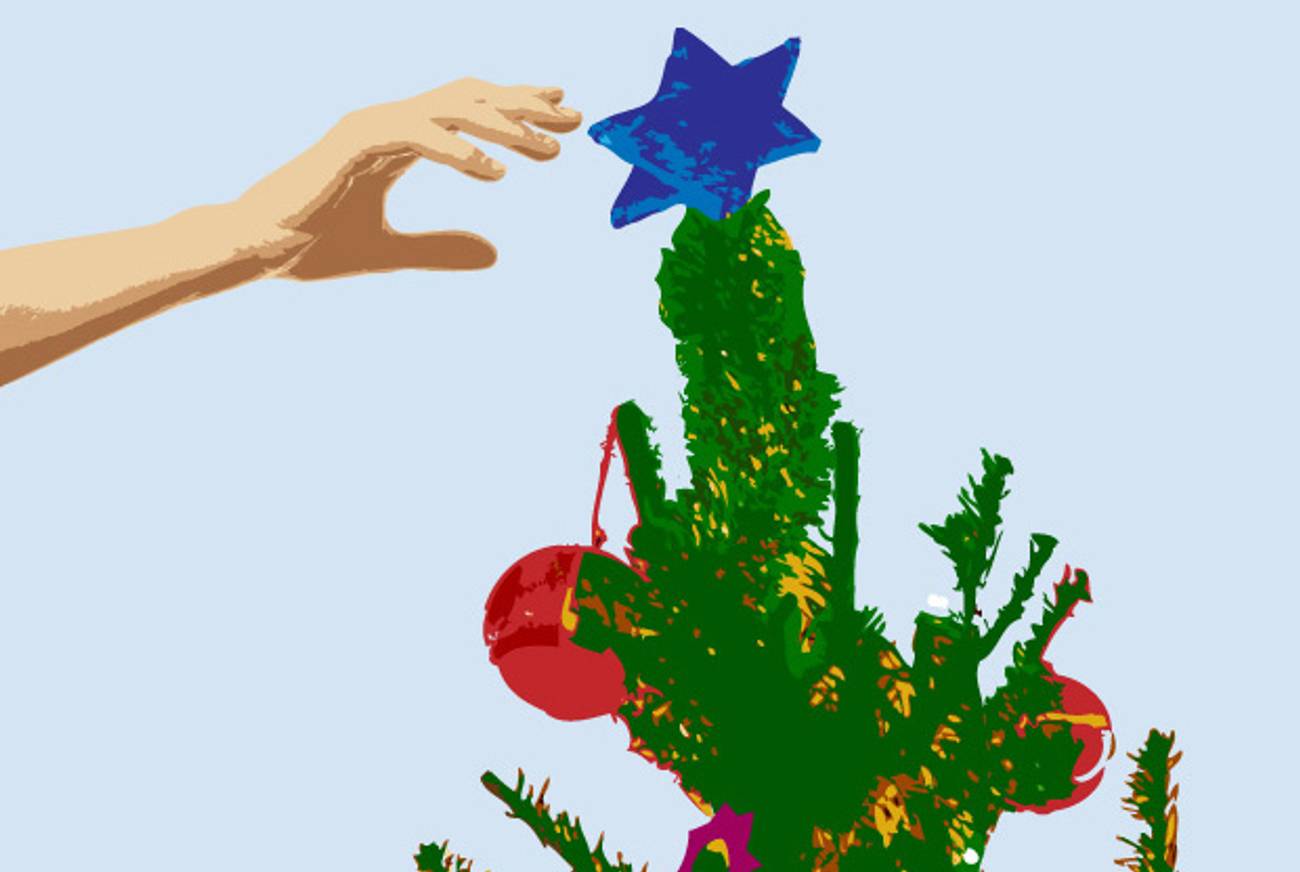Standing Tall
It’s the time of year when intermarried Jews are lectured against Christmas trees. Given marriage trends, the lecturers should learn to pipe down.




Now is the time of year when my wife and I renew our annual, uncomfortable conversation about why we will never have a Christmas tree in our home, despite her having grown up with one. I’m fairly crummy at explaining my reasoning, but we eventually remind ourselves that all marriages require give-and-take, and this is one time where she’s giving and I’m taking.
However, I’ve never felt more like getting a Christmas tree than this past week, thanks to the trend in Jewish media of non-intermarried Jews telling intermarried Jews not to have Christmas trees. Articles like these make me want to put up a Christmas tree just to symbolize my defiance of self-appointed assimilation police. Of course it wouldn’t work, because their very point is that I don’t get to decide what my own Christmas tree would symbolize. These writers assume that what the tree—or even “celebrating Christmas”—symbolizes to them is what it represents universally and objectively, beyond the touch of actual humans who make decisions and appoint significances based on their own needs, interests, and complex familial relationships.
Thankfully, I hear these recriminations about interfaith families less frequently than I used to. I’d be shocked if there is a single Reform rabbi out there who’d admit to an anti-Christmas-tree sermon in the past decade—and that’s not, as some cynics might argue, out of fear of unemployment. It’s because they know that the intermarried families they’d be chastising are within earshot only because they’ve dedicated countless hours and thousands of dollars toward raising Jewish children—often with the non-Jewish partner as the driving force. We should be thanking these folks, rather than pushing them away.
****
My wife is from Japan, a land of 127 million mostly secular Buddhists and Shintoists and almost no Christians. Yet almost all Japanese families put up Christmas trees and teach their kids to believe in Santa Claus. Try explaining the concept of Jesus as messiah to Japanese people and most will look at you politely but baffled. If my wife and I were to have a tree, would that represent “Christianity,” even though there are no Christians in our home?
Believe me, I get the objection. I understand the fears of assimilation. In many cases, it can be confusing for young children being raised Jewish to also celebrate Christmas in their home—which is why, in fact, I don’t feel like such a Grinch denying the tree to my own future children: Even though it was a part of my wife’s childhood experience, it’s not really a part of her true cultural heritage—and our kids will be confused enough being 100 percent American, 100 percent Jewish, and 100 percent Japanese. But after working with literally thousands of interfaith families as a Jewish communal professional over the past decade, I feel that I’m in a much better position to suggest what a Christmas tree actually symbolizes than those critics. The answer is: It depends who you ask.
There are well over a million intermarried Jews in the United States and likely more intermarried than single-faith households. There are more Americans under the age of 20 with one Jewish parent than there are with two. To make blanket statements about anything related to intermarried families is about as helpful as making blanket statements about “The Jews.” Can you imagine how many different responses you’d get if you put 20 Jews in a room and asked what the Hanukkah menorah symbolizes? If the math from the old Jewish joke holds, you’d have 30 opinions. Interfaith families are no different.
For many Jews looking in from the outside, a Christmas tree might represent the threatening, monolithic assertion: “Christian Household.” But for vast swaths of the intermarried population who put up Christmas trees but still successfully raise strongly identified Jews, that’s just not factually correct. And it’s why Tablet’s Marc Tracy drew the wrong red line when he wrote on the Scroll that the flexibility of identity requires some limits “and celebrating Christmas is beyond that limit.”
Really? Why does anyone get to decide that limit for someone else?
The overwhelming majority of Jews pick and choose which Jewish laws they find meaningful and which they reject. Keeping kosher all the time? Rejected by 85 percent of American Jewry. Believing homosexuality is an abomination? Thankfully, rejected by a growing majority. When we start telling each other that our own individual red lines are the universally accepted “Jewish” red lines—and if you cross them, you’re a bad Jew—our community descends into recriminations. Those of us working to actually grow the Jewish community understand that the message of “our way or the highway” more often than not results in the highway. Rather than telling people what they shouldn’t do, why not provide more ways for them to express their Jewish identity?
To me, the message of Hanukkah continues beyond the victorious Maccabees’ oppressive enforcement of Jewish ritual to the following decades, when it turns out that Judaism actually did “assimilate” many aspects of Greco-Roman thought, and that doing so made Judaism stronger. I believe Jewish ideas are strong enough today to survive comparisons to other religions, even within the same household. And that’s why I defend the right of interfaith families to acknowledge the heritage of their non-Jewish relatives’ traditions, including by putting up Christmas trees—even if I don’t endorse celebrating Christmas or exercise that right myself. (Sorry, honey.)
Hanukkah has only grown bigger year after year, even in many interfaith homes, which demonstrates that most American Jews don’t want to assimilate away into the warm embrace of tinsel and eggnog but instead are proclaiming their Jewish identity loudly and proudly. That is a miracle worth celebrating.
Paul Golin is co-author of How to Raise Jewish Children Even When You’re Not Jewish Yourself.
Paul Golin is co-author of How to Raise Jewish Children Even When You’re Not Jewish Yourself.